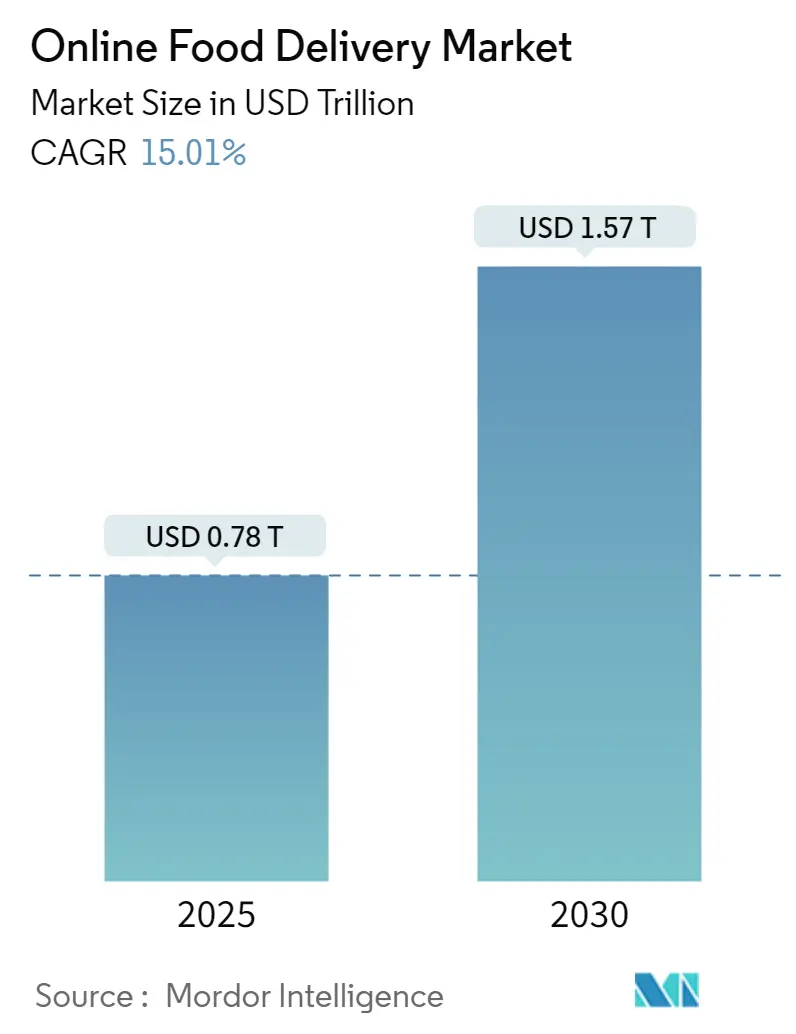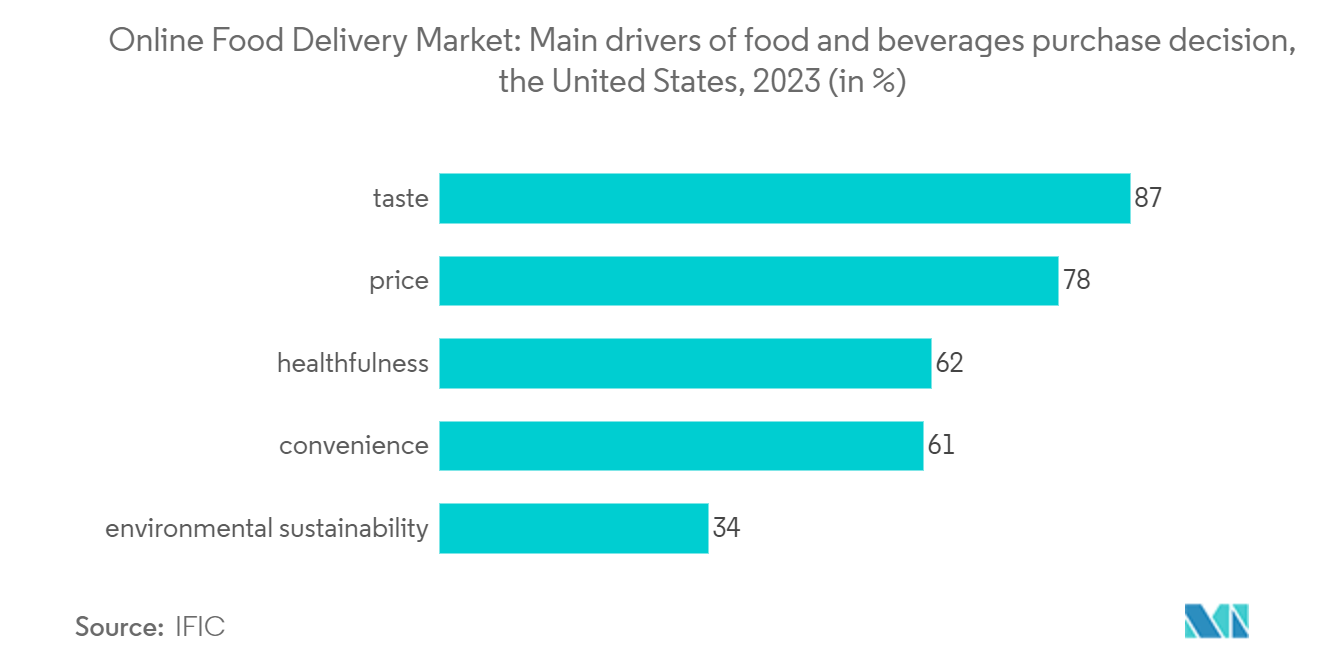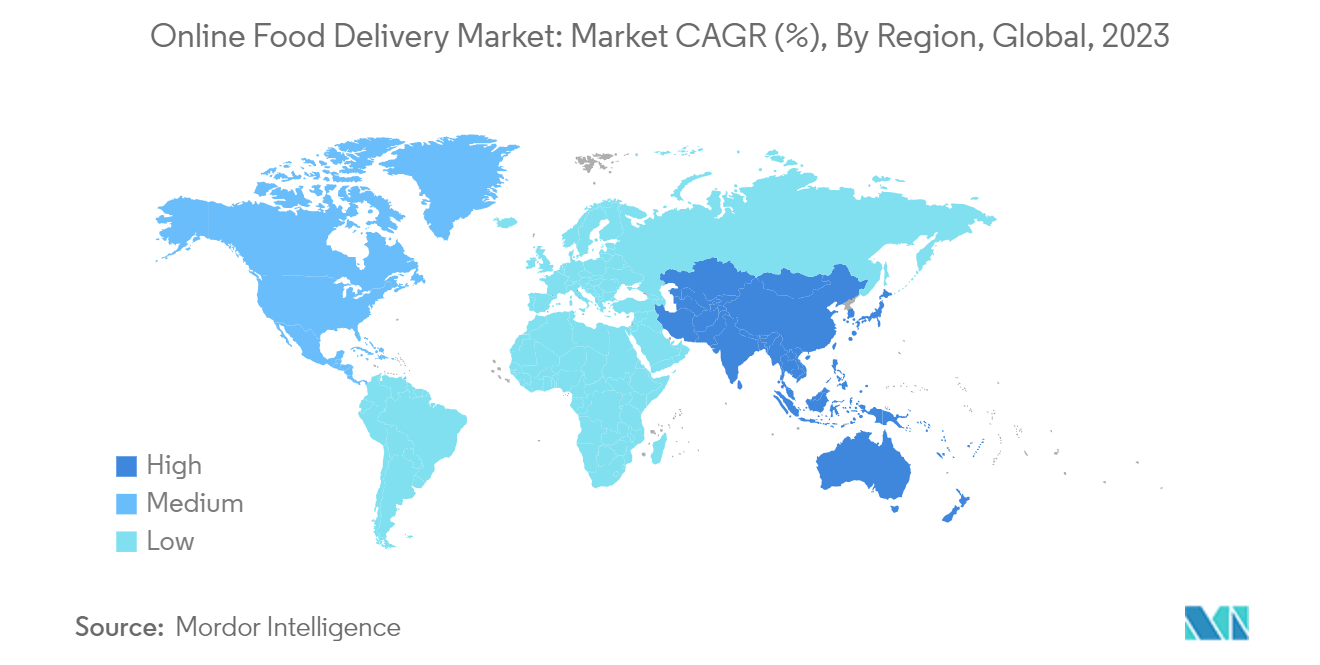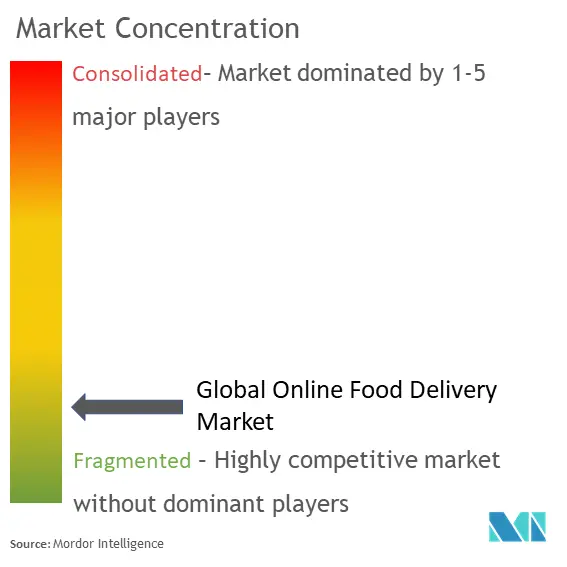Online Food Delivery Market Size and Share

Online Food Delivery Market Analysis by Mordor Intelligence
The Online Food Delivery Market size is estimated at USD 0.78 trillion in 2025, and is expected to reach USD 1.57 trillion by 2030, at a CAGR of 15.01% during the forecast period (2025-2030).
Online food delivery apps have become increasingly popular worldwide, with more and more consumers opting to order their meals online. The convenience of ordering meals online has led to a significant increase in consumers using online food delivery services. These services offer ease of ordering, the availability of a wide range of cuisines, and the ability to track orders in real time. Additionally, the COVID-19 pandemic has accelerated the adoption of online food delivery services as consumers look for contactless options to order food.
In the United States, the online food delivery market has seen significant growth, with the rise of third-party delivery services such as Uber Eats, DoorDash, and Grubhub. These platforms have become increasingly popular, particularly among younger consumers, who value the convenience and variety of options available. In China, the online food delivery market has become dominated by major players, Meituan and Ele Me, which have leveraged their scale to offer competitive pricing and a wide range of services. The market in Europe has presented a more diverse landscape with a mix of local and international players.
Overall, the online food delivery industry continues to evolve rapidly, driven by changing consumer habits, technological advancements, and market dynamics. As competition intensifies and consumer expectations evolve, players must continue to innovate and adapt to stay relevant in this dynamic landscape.
Global Online Food Delivery Market Trends and Insights
Sustainability And Healthy Eating Habits Driving Consumer Purchase Decisions
Consumers are becoming more health-conscious and are looking for food that meets their dietary and ethical preferences. Moreover, the growing concern for the environment and animal welfare drives the trend toward healthy and sustainable food options. As a result, online food delivery platforms are responding by offering a more comprehensive range of healthy and sustainable food options, such as plant-based meals, organic produce, and locally sourced ingredients. This trend is also reflected in the rise of niche food delivery services catering to vegan, vegetarian, gluten-free, or other dietary requirements. Players increasingly work with eco-friendly suppliers and adopt sustainable packaging and delivery practices. Some companies also partner with local farmers and food producers to reduce their carbon footprint and support local communities. Therefore, as consumers become more aware of the environmental and ethical impact of their food choices, the demand for healthy and sustainable food options is likely to continue to grow, shaping the future of the online food delivery market.

Asia Pacific Dominates the Market
The online food delivery market in Asia Pacific has risen in recent years, with more and more people turning to the convenience of having their meals and household essentials delivered straight to their door. The growth can be attributed to various factors, including rising disposable income, the increasing penetration of mobile devices, and changing consumer preferences. Additionally, the COVID-19 pandemic has accelerated the adoption of online food delivery services as consumers look for safe and convenient ways to order food. Another significant trend is the integration of technology and innovation. Companies use advanced technologies like artificial intelligence, machine learning, and data analytics to improve their services and offer a better user experience. This includes features like personalized recommendations, real-time tracking, and predictive delivery. Furthermore, the expansion of ghost kitchens is expected to reduce delivery times, increase efficiency in the food delivery process, and drive the overall market.

Competitive Landscape
The Online Food Delivery Market is highly competitive, with many players vying for market share and profitability remaining challenging for many companies. Some leading players offering online food delivery services include Delivery Hero SE, Doordash, Just Eat Holding Limited, Deliveroo, and Uber Technologies Inc. The key strategies companies prefer to strengthen their market dominance include expansion, mergers and acquisitions, and partnerships to consolidate and optimize their offerings. Besides expanding their business size and reach, companies emphasize R&D in developing technologically advanced and differentiated services to gain a competitive edge.
Online Food Delivery Industry Leaders
-
Delivery Hero SE
-
Just Eat Holding Limited
-
Uber Technologies Inc.
-
Doordash
-
Deliveroo
- *Disclaimer: Major Players sorted in no particular order

Recent Industry Developments
- April 2024: Uber Eats partnered with Waymo to provide autonomous rides in Phoenix. Uber Eats also launched deliveries via Waymo self-driving vehicles. Additionally, Uber and Waymo are working with select merchants in the area, including local favorites like Princess Pita, Filiberto’s, and Bosa Donuts.
- April 2024: Zomato launched a "large order fleet" to handle orders for groups of people or events. This was claimed to be an all-electric fleet explicitly designed to serve orders for a gathering of up to 50 people.
- April 2024: DoorDash Inc. enabled over 180,000 orders with reusable packaging globally across the countries DoorDash and Wolt operate. The company is working to grow that number in partnership with DeliverZero in the United States.
Global Online Food Delivery Market Report Scope
Online food delivery is a service through which the user orders food or groceries from the desired food outlet via the Internet.
The global online food delivery market is segmented by business model, platform type, and geography. Based on the business model, the market is segmented into a logistics-focused food delivery system and a restaurant-specific food delivery system. Based on the platform type, the market is segmented into mobile/tablet applications and websites. Based on geography, the market is segmented into North America, Europe, Asia-Pacific, South America, and the Middle East and Africa.
The report offers market size and forecast in value terms in USD for all the above segments.
| Logistics-focused Food Delivery System |
| Restaurant-specific Food Delivery System |
| Mobile/Tablet Applications |
| Websites |
| North America | United States |
| Canada | |
| Mexico | |
| Rest of North America | |
| Europe | Spain |
| United Kingdom | |
| Germany | |
| France | |
| Italy | |
| Russia | |
| Rest of Europe | |
| Asia-Pacific | China |
| Japan | |
| India | |
| Australia | |
| Rest of Asia-Pacific | |
| South America | Brazil |
| Argentina | |
| Rest of South America | |
| Middle-East and Africa | United Arab Emirates |
| South Africa | |
| Rest of Middle-East and Africa |
| Business Model | Logistics-focused Food Delivery System | |
| Restaurant-specific Food Delivery System | ||
| Platform Type | Mobile/Tablet Applications | |
| Websites | ||
| Geography | North America | United States |
| Canada | ||
| Mexico | ||
| Rest of North America | ||
| Europe | Spain | |
| United Kingdom | ||
| Germany | ||
| France | ||
| Italy | ||
| Russia | ||
| Rest of Europe | ||
| Asia-Pacific | China | |
| Japan | ||
| India | ||
| Australia | ||
| Rest of Asia-Pacific | ||
| South America | Brazil | |
| Argentina | ||
| Rest of South America | ||
| Middle-East and Africa | United Arab Emirates | |
| South Africa | ||
| Rest of Middle-East and Africa | ||
Key Questions Answered in the Report
How big is the Online Food Delivery Market?
The Online Food Delivery Market size is expected to reach USD 0.68 trillion in 2024 and grow at a CAGR of 15.01% to reach USD 1.37 trillion by 2029.
What is the current Online Food Delivery Market size?
In 2024, the Online Food Delivery Market size is expected to reach USD 0.68 trillion.
Who are the key players in Online Food Delivery Market?
Delivery Hero SE, Just Eat Holding Limited, Uber Technologies Inc., Doordash and Deliveroo are the major companies operating in the Online Food Delivery Market.
Which is the fastest growing region in Online Food Delivery Market?
Asia-Pacific is estimated to grow at the highest CAGR over the forecast period (2024-2029).
Which region has the biggest share in Online Food Delivery Market?
In 2024, the Asia Pacific accounts for the largest market share in Online Food Delivery Market.
What years does this Online Food Delivery Market cover, and what was the market size in 2023?
In 2023, the Online Food Delivery Market size was estimated at USD 0.58 trillion. The report covers the Online Food Delivery Market historical market size for years: 2019, 2020, 2021, 2022 and 2023. The report also forecasts the Online Food Delivery Market size for years: 2024, 2025, 2026, 2027, 2028 and 2029.
What are the key factors driving the Online Food Delivery Market?
The key factors driving the Online Food Delivery Market are a) The rising number of smartphone and internet users b) Growing trends toward food delivery mobile applications across the globe
What are the key factors driving the Online Food Delivery Market?
The key factors driving the Online Food Delivery Market are a) The rising number of smartphone and internet users b) Growing trends toward food delivery mobile applications across the globe
Page last updated on:
Online Food Delivery Market Report
The online food delivery market is experiencing significant growth, driven by increased internet and smartphone penetration alongside technological advancements. The rise of cloud kitchens, which offer cost-effective operational models, is particularly appealing to restaurants aiming to adapt to changing market dynamics. The market is dominated by the platform-to-consumer delivery segment, benefiting from widespread internet access. Additionally, the restaurant-to-consumer segment is expected to see notable growth due to improved connectivity and logistics.
Innovations such as Kitchen Display Systems (KDS) are enhancing order management and boosting the online presence of restaurants. Despite challenges in managing delivery volumes, the demand for convenience, safety, and customizable options continues to drive market opportunities. The industry overview indicates a robust market size and market share, suggesting a positive market growth trajectory.
The market report provides comprehensive industry analysis and market research, highlighting the target market and global market trends. The report pdf is available for those seeking detailed industry information and market data. The market forecast and market outlook suggest ongoing growth, supported by industry reports and market leaders.
This industry research reveals significant industry sales and industry size, with industry statistics underscoring the importance of market segmentation and market value. The report example illustrates the market review and market predictions, offering insights into industry trends and market overview.
Overall, the industry outlook remains positive, with industry research companies continuously monitoring market growth and market leaders. The report pdf serves as a valuable resource for understanding the market forecast and market review, providing a comprehensive view of the online food delivery market.
.webp)


